Chemistry Lab Report: Reduction of Camphor and Reaction Mechanism
VerifiedAdded on 2021/04/17
|7
|751
|419
Practical Assignment
AI Summary
This chemistry lab report details the reduction of camphor using sodium borohydride as a reducing agent. The experiment involves dissolving camphor in methanol and reacting it with sodium borohydride, followed by a hot water bath and cooling. The report outlines the objectives, introduction, materials, procedure, results, and discussion, including the reaction mechanism and the role of temperature. The results section notes that the reaction rate increases with temperature. The discussion focuses on the high reducing power of sodium borohydride and its application in reducing aldehydes and ketones to primary alcohols. The conclusion summarizes the use of sodium borohydride in camphor reduction and the impact of temperature on the reaction rate. The report also includes references to relevant scientific literature.
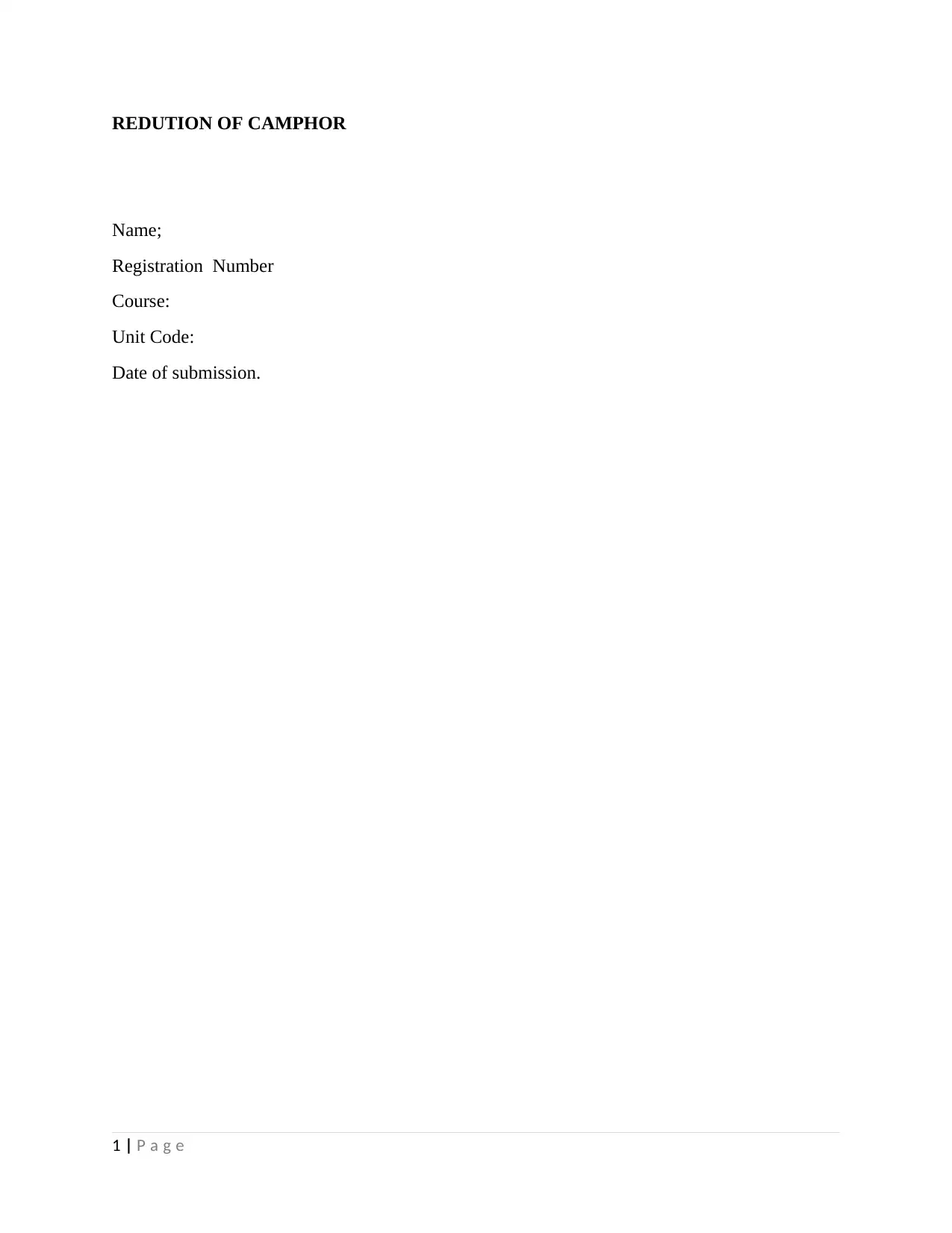
REDUTION OF CAMPHOR
Name;
Registration Number
Course:
Unit Code:
Date of submission.
1 | P a g e
Name;
Registration Number
Course:
Unit Code:
Date of submission.
1 | P a g e
Paraphrase This Document
Need a fresh take? Get an instant paraphrase of this document with our AI Paraphraser
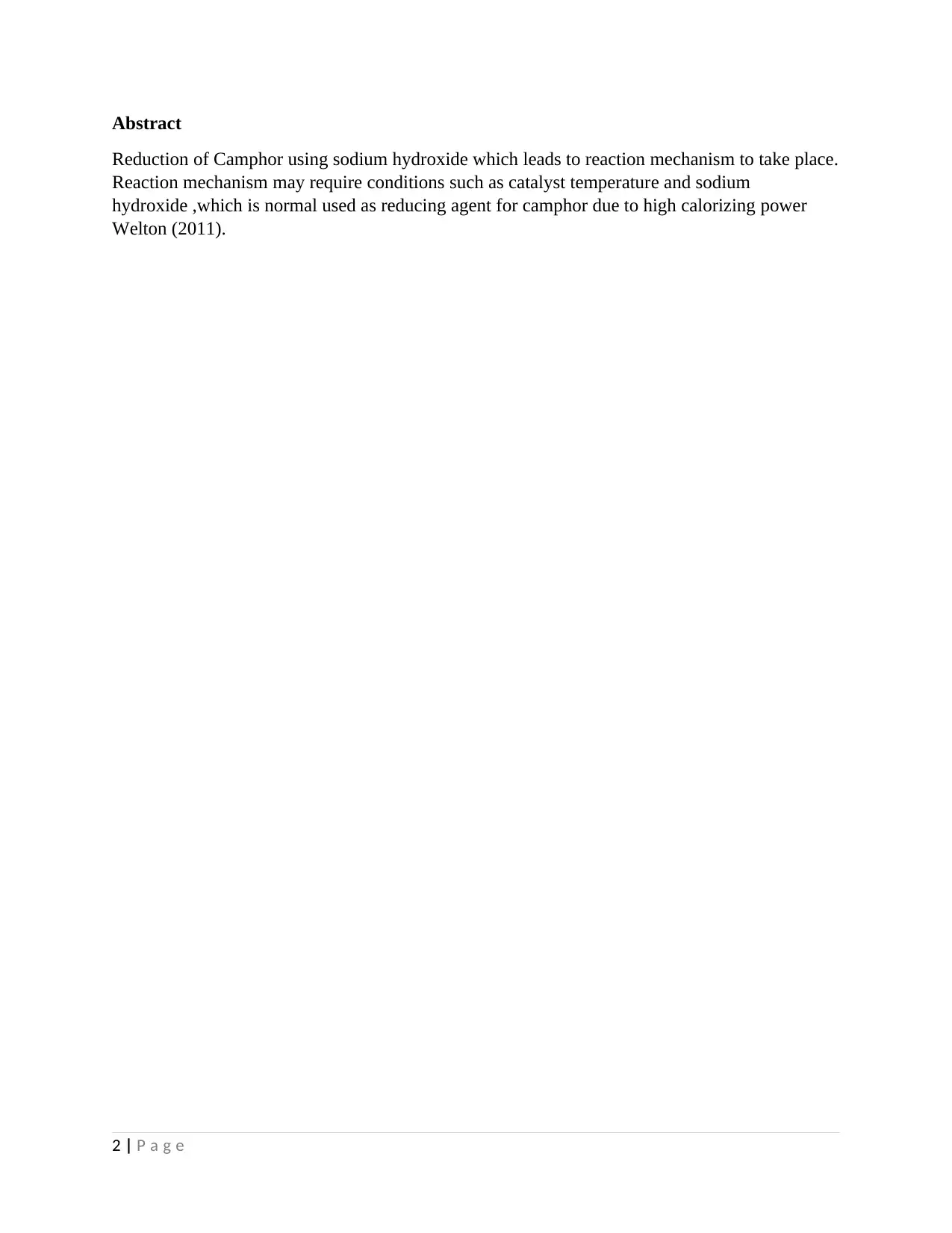
Abstract
Reduction of Camphor using sodium hydroxide which leads to reaction mechanism to take place.
Reaction mechanism may require conditions such as catalyst temperature and sodium
hydroxide ,which is normal used as reducing agent for camphor due to high calorizing power
Welton (2011).
2 | P a g e
Reduction of Camphor using sodium hydroxide which leads to reaction mechanism to take place.
Reaction mechanism may require conditions such as catalyst temperature and sodium
hydroxide ,which is normal used as reducing agent for camphor due to high calorizing power
Welton (2011).
2 | P a g e
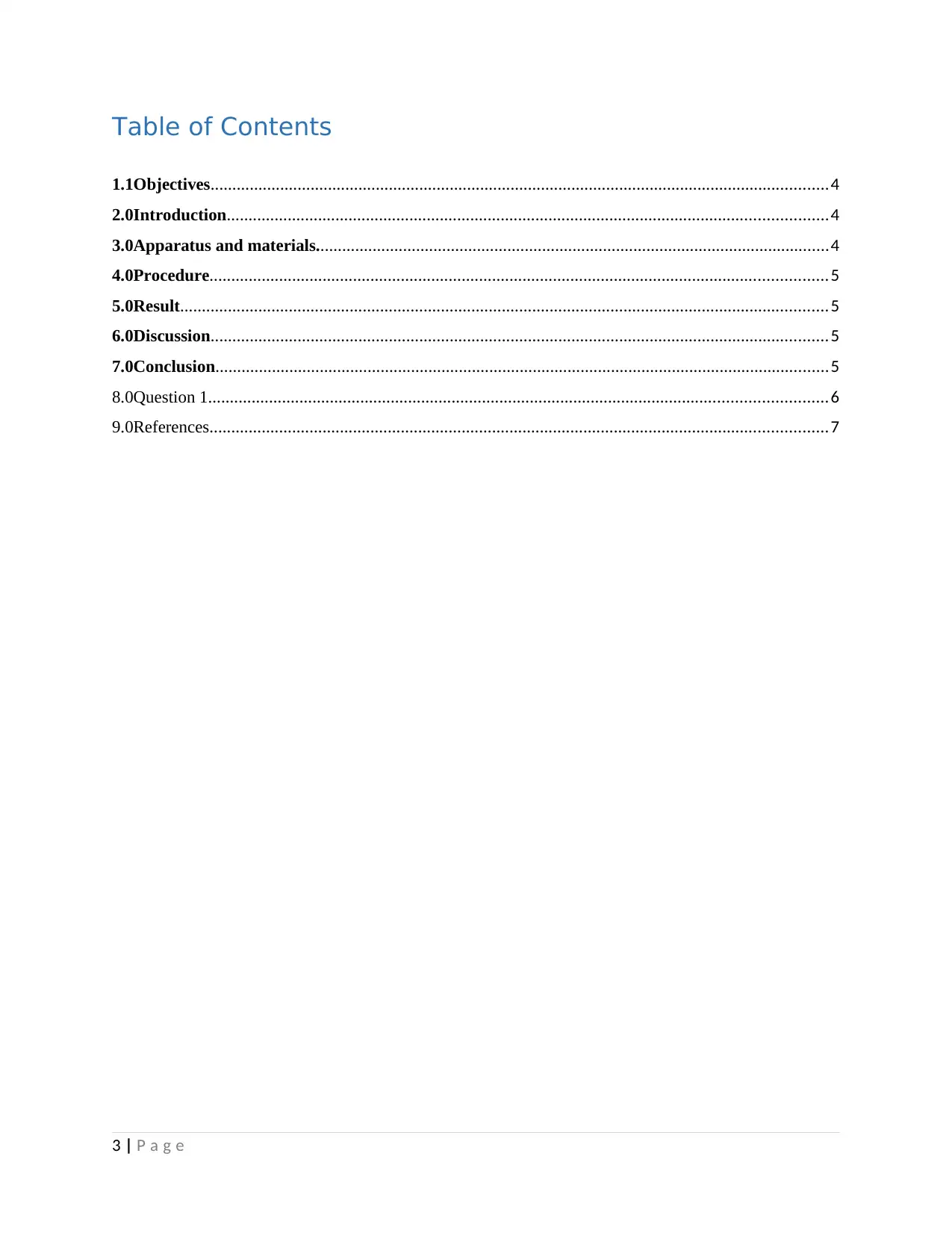
Table of Contents
1.1Objectives..............................................................................................................................................4
2.0Introduction..........................................................................................................................................4
3.0Apparatus and materials......................................................................................................................4
4.0Procedure..............................................................................................................................................5
5.0Result.....................................................................................................................................................5
6.0Discussion..............................................................................................................................................5
7.0Conclusion.............................................................................................................................................5
8.0Question 1..............................................................................................................................................6
9.0References..............................................................................................................................................7
3 | P a g e
1.1Objectives..............................................................................................................................................4
2.0Introduction..........................................................................................................................................4
3.0Apparatus and materials......................................................................................................................4
4.0Procedure..............................................................................................................................................5
5.0Result.....................................................................................................................................................5
6.0Discussion..............................................................................................................................................5
7.0Conclusion.............................................................................................................................................5
8.0Question 1..............................................................................................................................................6
9.0References..............................................................................................................................................7
3 | P a g e
⊘ This is a preview!⊘
Do you want full access?
Subscribe today to unlock all pages.

Trusted by 1+ million students worldwide
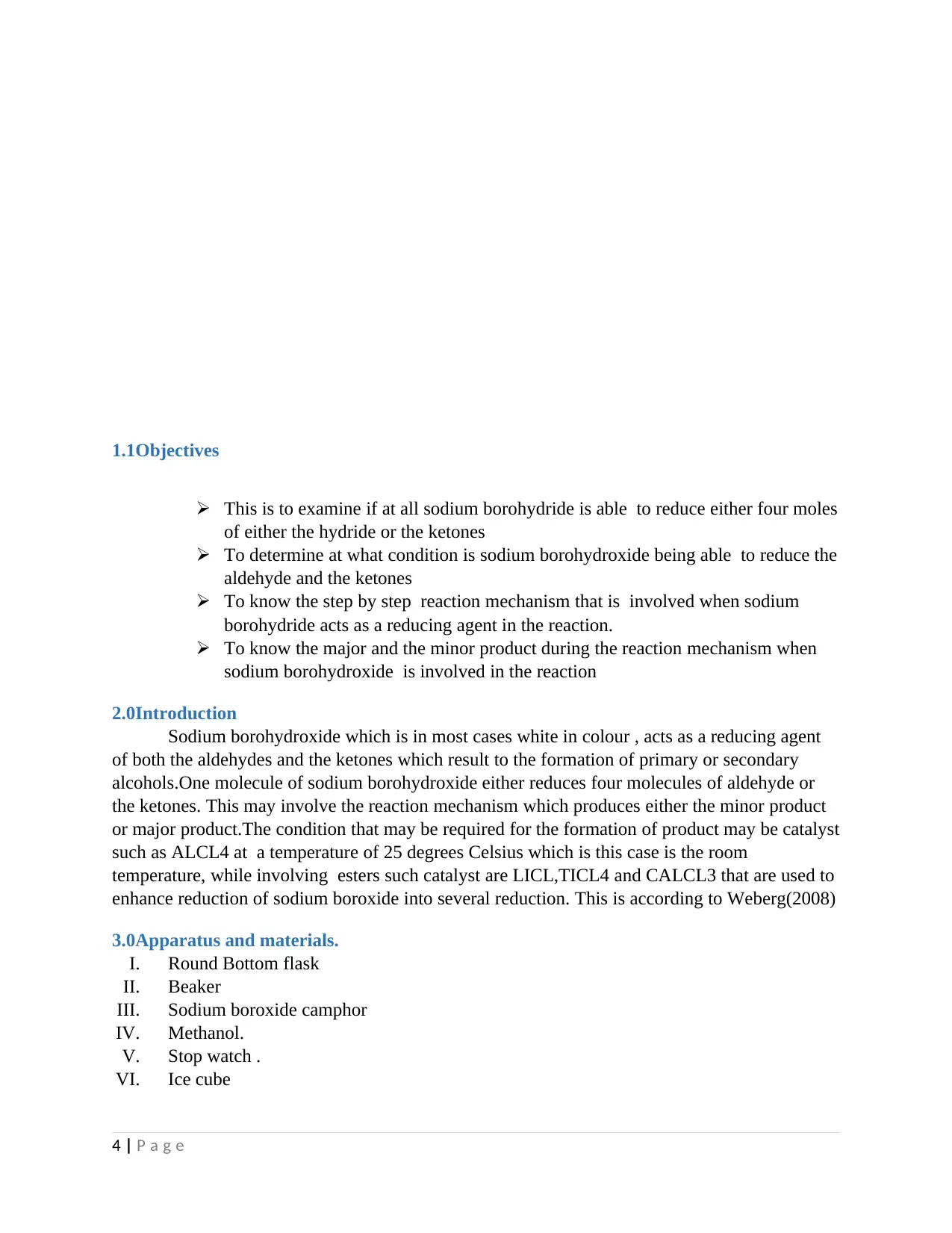
1.1Objectives
This is to examine if at all sodium borohydride is able to reduce either four moles
of either the hydride or the ketones
To determine at what condition is sodium borohydroxide being able to reduce the
aldehyde and the ketones
To know the step by step reaction mechanism that is involved when sodium
borohydride acts as a reducing agent in the reaction.
To know the major and the minor product during the reaction mechanism when
sodium borohydroxide is involved in the reaction
2.0Introduction
Sodium borohydroxide which is in most cases white in colour , acts as a reducing agent
of both the aldehydes and the ketones which result to the formation of primary or secondary
alcohols.One molecule of sodium borohydroxide either reduces four molecules of aldehyde or
the ketones. This may involve the reaction mechanism which produces either the minor product
or major product.The condition that may be required for the formation of product may be catalyst
such as ALCL4 at a temperature of 25 degrees Celsius which is this case is the room
temperature, while involving esters such catalyst are LICL,TICL4 and CALCL3 that are used to
enhance reduction of sodium boroxide into several reduction. This is according to Weberg(2008)
3.0Apparatus and materials.
I. Round Bottom flask
II. Beaker
III. Sodium boroxide camphor
IV. Methanol.
V. Stop watch .
VI. Ice cube
4 | P a g e
This is to examine if at all sodium borohydride is able to reduce either four moles
of either the hydride or the ketones
To determine at what condition is sodium borohydroxide being able to reduce the
aldehyde and the ketones
To know the step by step reaction mechanism that is involved when sodium
borohydride acts as a reducing agent in the reaction.
To know the major and the minor product during the reaction mechanism when
sodium borohydroxide is involved in the reaction
2.0Introduction
Sodium borohydroxide which is in most cases white in colour , acts as a reducing agent
of both the aldehydes and the ketones which result to the formation of primary or secondary
alcohols.One molecule of sodium borohydroxide either reduces four molecules of aldehyde or
the ketones. This may involve the reaction mechanism which produces either the minor product
or major product.The condition that may be required for the formation of product may be catalyst
such as ALCL4 at a temperature of 25 degrees Celsius which is this case is the room
temperature, while involving esters such catalyst are LICL,TICL4 and CALCL3 that are used to
enhance reduction of sodium boroxide into several reduction. This is according to Weberg(2008)
3.0Apparatus and materials.
I. Round Bottom flask
II. Beaker
III. Sodium boroxide camphor
IV. Methanol.
V. Stop watch .
VI. Ice cube
4 | P a g e
Paraphrase This Document
Need a fresh take? Get an instant paraphrase of this document with our AI Paraphraser
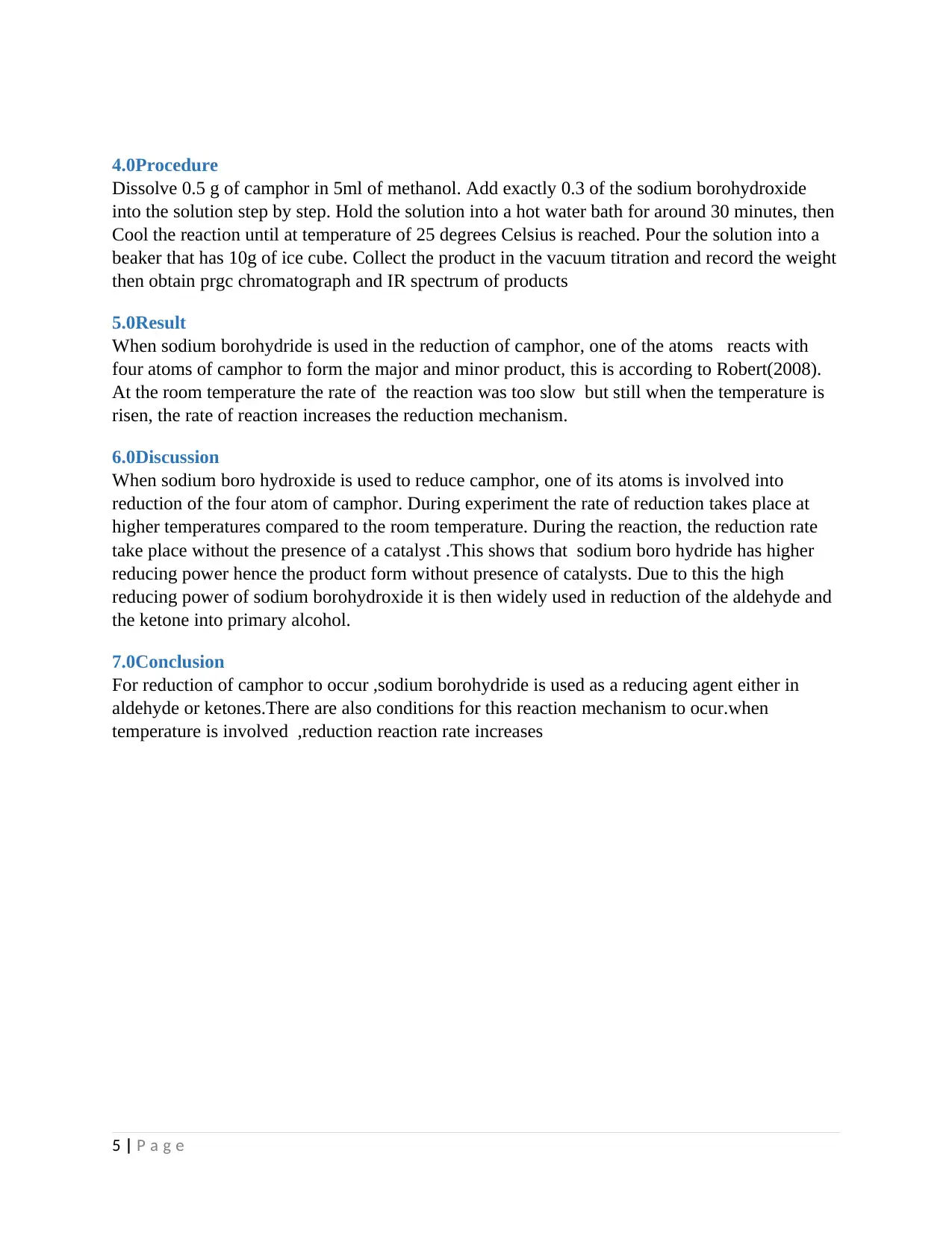
4.0Procedure
Dissolve 0.5 g of camphor in 5ml of methanol. Add exactly 0.3 of the sodium borohydroxide
into the solution step by step. Hold the solution into a hot water bath for around 30 minutes, then
Cool the reaction until at temperature of 25 degrees Celsius is reached. Pour the solution into a
beaker that has 10g of ice cube. Collect the product in the vacuum titration and record the weight
then obtain prgc chromatograph and IR spectrum of products
5.0Result
When sodium borohydride is used in the reduction of camphor, one of the atoms reacts with
four atoms of camphor to form the major and minor product, this is according to Robert(2008).
At the room temperature the rate of the reaction was too slow but still when the temperature is
risen, the rate of reaction increases the reduction mechanism.
6.0Discussion
When sodium boro hydroxide is used to reduce camphor, one of its atoms is involved into
reduction of the four atom of camphor. During experiment the rate of reduction takes place at
higher temperatures compared to the room temperature. During the reaction, the reduction rate
take place without the presence of a catalyst .This shows that sodium boro hydride has higher
reducing power hence the product form without presence of catalysts. Due to this the high
reducing power of sodium borohydroxide it is then widely used in reduction of the aldehyde and
the ketone into primary alcohol.
7.0Conclusion
For reduction of camphor to occur ,sodium borohydride is used as a reducing agent either in
aldehyde or ketones.There are also conditions for this reaction mechanism to ocur.when
temperature is involved ,reduction reaction rate increases
5 | P a g e
Dissolve 0.5 g of camphor in 5ml of methanol. Add exactly 0.3 of the sodium borohydroxide
into the solution step by step. Hold the solution into a hot water bath for around 30 minutes, then
Cool the reaction until at temperature of 25 degrees Celsius is reached. Pour the solution into a
beaker that has 10g of ice cube. Collect the product in the vacuum titration and record the weight
then obtain prgc chromatograph and IR spectrum of products
5.0Result
When sodium borohydride is used in the reduction of camphor, one of the atoms reacts with
four atoms of camphor to form the major and minor product, this is according to Robert(2008).
At the room temperature the rate of the reaction was too slow but still when the temperature is
risen, the rate of reaction increases the reduction mechanism.
6.0Discussion
When sodium boro hydroxide is used to reduce camphor, one of its atoms is involved into
reduction of the four atom of camphor. During experiment the rate of reduction takes place at
higher temperatures compared to the room temperature. During the reaction, the reduction rate
take place without the presence of a catalyst .This shows that sodium boro hydride has higher
reducing power hence the product form without presence of catalysts. Due to this the high
reducing power of sodium borohydroxide it is then widely used in reduction of the aldehyde and
the ketone into primary alcohol.
7.0Conclusion
For reduction of camphor to occur ,sodium borohydride is used as a reducing agent either in
aldehyde or ketones.There are also conditions for this reaction mechanism to ocur.when
temperature is involved ,reduction reaction rate increases
5 | P a g e
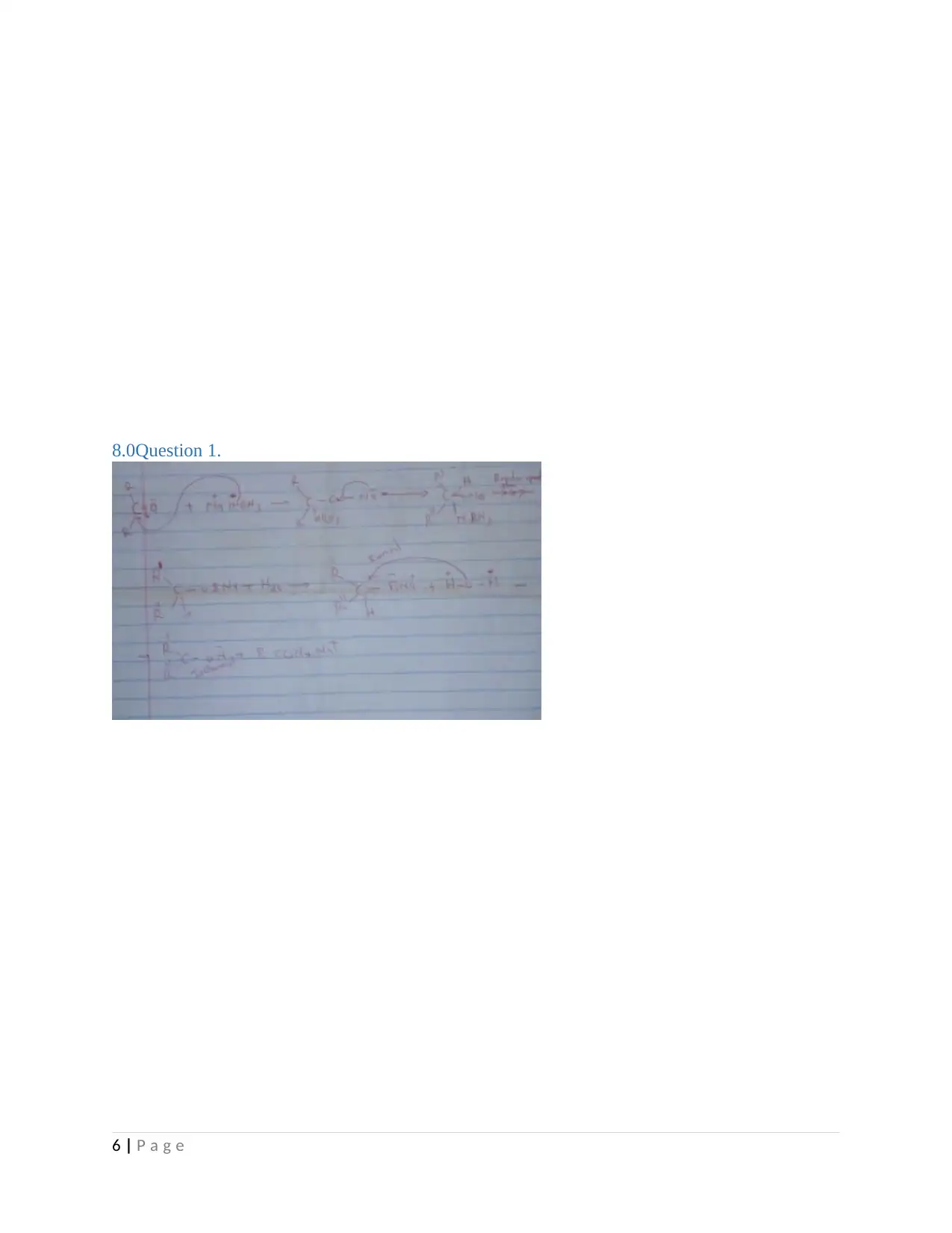
8.0Question 1.
6 | P a g e
6 | P a g e
⊘ This is a preview!⊘
Do you want full access?
Subscribe today to unlock all pages.

Trusted by 1+ million students worldwide
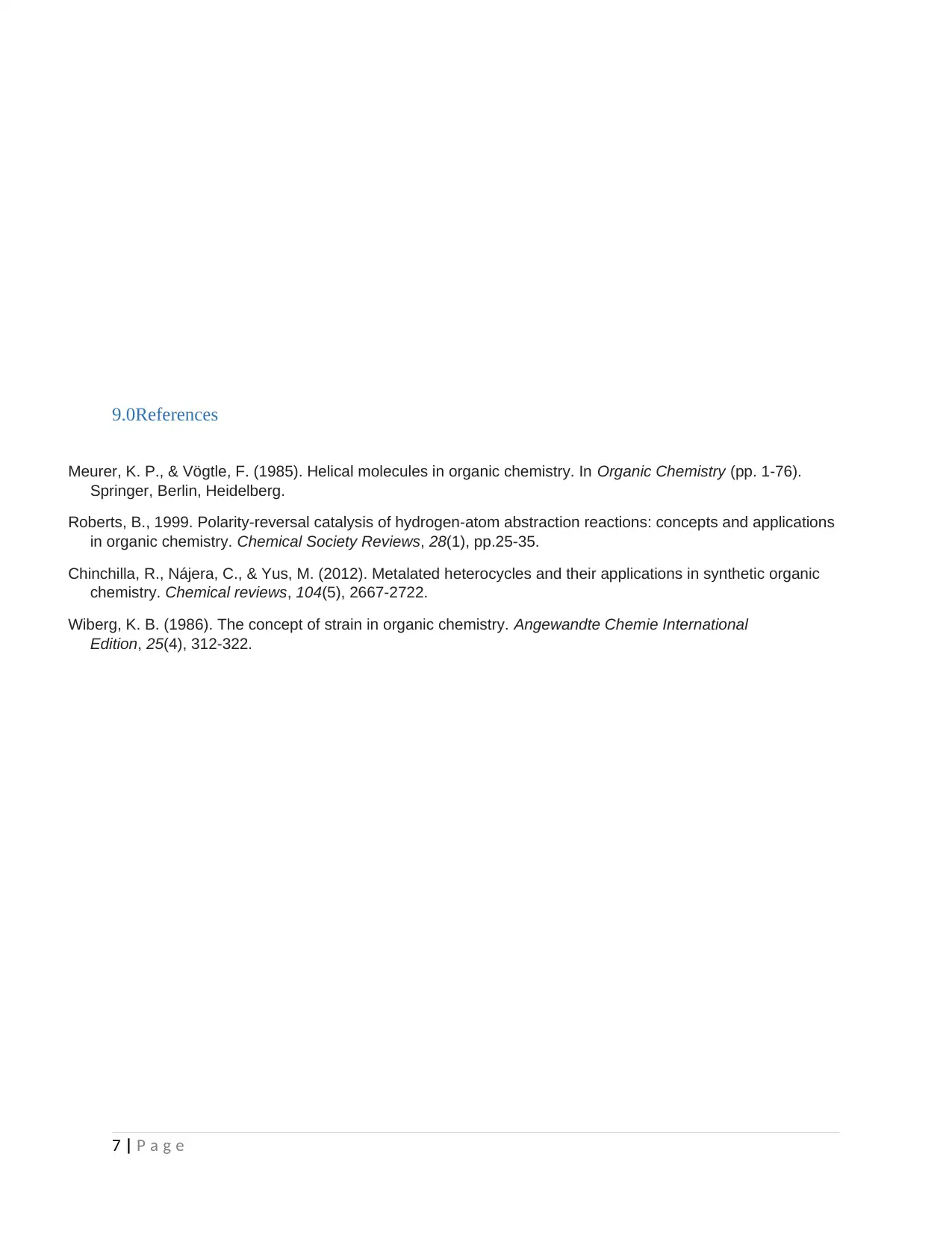
9.0References
Meurer, K. P., & Vögtle, F. (1985). Helical molecules in organic chemistry. In Organic Chemistry (pp. 1-76).
Springer, Berlin, Heidelberg.
Roberts, B., 1999. Polarity-reversal catalysis of hydrogen-atom abstraction reactions: concepts and applications
in organic chemistry. Chemical Society Reviews, 28(1), pp.25-35.
Chinchilla, R., Nájera, C., & Yus, M. (2012). Metalated heterocycles and their applications in synthetic organic
chemistry. Chemical reviews, 104(5), 2667-2722.
Wiberg, K. B. (1986). The concept of strain in organic chemistry. Angewandte Chemie International
Edition, 25(4), 312-322.
7 | P a g e
Meurer, K. P., & Vögtle, F. (1985). Helical molecules in organic chemistry. In Organic Chemistry (pp. 1-76).
Springer, Berlin, Heidelberg.
Roberts, B., 1999. Polarity-reversal catalysis of hydrogen-atom abstraction reactions: concepts and applications
in organic chemistry. Chemical Society Reviews, 28(1), pp.25-35.
Chinchilla, R., Nájera, C., & Yus, M. (2012). Metalated heterocycles and their applications in synthetic organic
chemistry. Chemical reviews, 104(5), 2667-2722.
Wiberg, K. B. (1986). The concept of strain in organic chemistry. Angewandte Chemie International
Edition, 25(4), 312-322.
7 | P a g e
1 out of 7
Your All-in-One AI-Powered Toolkit for Academic Success.
+13062052269
info@desklib.com
Available 24*7 on WhatsApp / Email
![[object Object]](/_next/static/media/star-bottom.7253800d.svg)
Unlock your academic potential
Copyright © 2020–2025 A2Z Services. All Rights Reserved. Developed and managed by ZUCOL.

